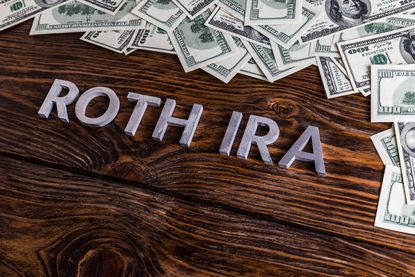Roth IRA Contribution Limits for 2024 and 2025
Roth IRA contribution limits have gone up. Here's a look at the 2024 and 2025 limits and income-based phaseouts.

Roth IRAs are a great way to save for retirement, allowing you to contribute after-tax dollars to an account in which the contributions and earnings grow tax-free. The contribution limits for 2025 are unchanged from 2024, the I.R.S. recently announced.
Don't forget you can open and contribute to a 2024 Roth IRA until the due date of your 2024 tax return on Tuesday April 15, 2025.
Here's what you need to know about 2024 and 2025 Roth IRA contribution and income limits.

Sign up for Kiplinger’s Free E-Newsletters
Profit and prosper with the best of expert advice on investing, taxes, retirement, personal finance and more - straight to your e-mail.
Profit and prosper with the best of expert advice - straight to your e-mail.
2024 and 2025 Roth IRA contribution limits and income limits
The maximum amount you can contribute to a Roth IRA for 2025 and 2024 is $7,000 if you're younger than age 50. If you're age 50 and older, you can add an extra $1,000 per year in "catch-up" contributions, bringing the total contribution to $8,000. The catch-up contribution was also $1000 in 2023.
The actual amount that you are allowed to contribute to a Roth IRA is based on your income. To be eligible to contribute the maximum amount in 2024, your modified adjusted gross income (MAGI) must be less than $146,000 (up from $138,000 last year) if single, or $230,000 (up from $218,000) if married and filing jointly.
For 2025, to contribute the maximum amount, your modified adjusted gross income (MAGI) must be less than $150,000 (up from $146,000 last year) if single or less than $236,000 (versus $230,000 in 2024) if married and filing jointly.
Contributions begin phasing out above those amounts, and you can't put any money into a Roth IRA once your income reaches $161,000 if a single filer or $240,000 if married and filing jointly in 2024 and $165,000 and $246,000 respectively in 2025.
Roth IRAs vs. traditional IRAs: What's the difference?
Unlike contributions to a traditional IRA, which may be tax-deductible, a Roth IRA has no up-front tax break. Money goes into the Roth after it has already been taxed. But when you start pulling money out in retirement, your withdrawals will be tax-free.
Also, Roths — unlike traditional IRAs — are not subject to required minimum distributions (RMDs) after age 73.
Roths are also more flexible than traditional, deductible IRAs. You can withdraw contributions from a Roth account anytime, tax- and penalty-free. If you want to withdraw earnings tax-free, though, you must be at least age 59-1/2, and you must have owned the Roth for at least five years. The clock on the five-year holding period starts ticking on January 1 of the year you open the account.
You can open a Roth IRA through a bank, brokerage, mutual fund or insurance company, and you can invest your retirement money in stocks, bonds, mutual funds, exchange-traded funds and other approved investments. You have until the federal tax filing deadline to make your Roth IRA contribution for the prior year.
Is a Roth IRA right for you?
There isn't a minimum age limit to open a Roth IRA, and you can contribute to another person's Roth account as a gift — perfect for parents looking to kick-start a child's retirement savings. Two caveats: Recipients must have earned income, and you can only contribute an amount up to that person's annual earnings or $7,000, whichever is less.
Financial experts generally recommend Roths for people who anticipate a greater tax burden in retirement, whether because of rising income or higher tax rates in general. By paying the taxes on those contributions while your income or tax rate is lower, you’ll reap the benefit of tax-free money later when it counts more. This is especially true for someone who plans to retire in 2026 or later. Unless Congress intervenes, current income tax rates are supposed to sunset at the end of 2025 and revert to 2017 income tax rates beginning January 1, 2026. If that happens, here’s a sample of what you can expect: The current 12% rate becomes 15%, the 22% rate rises to 25%, and the 24% rate jumps to 28%.
Roths can also provide valuable tax diversification in retirement and can be a great way to balance other sources of income, such as withdrawals from a 401(k) or Roth IRA and Social Security payments. For instance, those tax-free Roth withdrawals in retirement won’t contribute to your taxable income, which is used to determine how much you pay for Medicare, including any surcharges (also known as income-related monthly adjustment amounts or IRMAAs).
Finally, note that if you invest in both a Roth IRA and a traditional IRA, the total amount of money you contribute to both accounts can't exceed the annual limit. If you do exceed it, the IRS might hit you with a 6% excessive contribution penalty.
Roth IRA savings tips
To make the most of saving for retirement in your Roth IRA:
- Max out your contributions. For each year that you're able, aim to hit the $7,000 limit.
- Once you turn 50, add another $1,000 to that limit annually. You can add funds to your Roth for as long as you have earnings from work.
- Avoid withdrawing funds you contributed to your account, even though you can do so without penalties or taxes. Letting that money grow in the account over many years means a bigger nest egg in retirement.
Related Content
- Roth 401(k) Contribution Limits For 2024
- Higher IRA and 401(k) Contribution Limits for 2024
- 457 Contribution Limits for 2024
- Backdoor Roth IRAs: Retirees, Make the Most of a Roth's Back Door
Get Kiplinger Today newsletter — free
Profit and prosper with the best of Kiplinger's advice on investing, taxes, retirement, personal finance and much more. Delivered daily. Enter your email in the box and click Sign Me Up.
Jackie Stewart is the senior retirement editor for Kiplinger.com and the senior editor for Kiplinger's Retirement Report.
- Erin BendigPersonal Finance Writer
-
 Stock Market Today: Dow Climbs 288 Points After Amazon, Intel Earnings
Stock Market Today: Dow Climbs 288 Points After Amazon, Intel EarningsPost-earnings strength from Amazon and Intel helped cushion the blow of a disappointing October jobs report.
By David Dittman Published
-
 Stocks Rally on Election Day as Markets Brace for Volatility
Stocks Rally on Election Day as Markets Brace for VolatilityAll three major indexes opened higher as voters chose the 47th President of the United States.
By Dan Burrows Published
-
 Are You an Estate Planning Procrastinator? Where to Start
Are You an Estate Planning Procrastinator? Where to StartQuit putting it off, because it's vital for you and your heirs. From wills and trusts to executors and taxes, here are some essential points to keep in mind.
By Alex Diaz, MBA, CFP® Published
-
 The Bare Necessities of Buying Pet Insurance
The Bare Necessities of Buying Pet InsurancePet insurance can help put you at ease over the health of your furry friends. Here's what to look for when shopping around for a policy.
By Joelle Spear, CFP® Published
-
 Is It Too Late to Do a Roth Conversion if You're Retired?
Is It Too Late to Do a Roth Conversion if You're Retired?The short answer is: Not at all. Roth conversions can be great tax-saving strategies … for the right people. Are you a good candidate?
By Arrin Wray Published
-
 Five Options for Retirees Who No Longer Need Life Insurance
Five Options for Retirees Who No Longer Need Life InsuranceIf you're retired and you've checked with your financial planner that life insurance is no longer vital, here are five ways you can turn it to your advantage.
By Evan T. Beach, CFP®, AWMA® Published
-
 Medicare Drug Plans Are Getting Better Next Year. Some Will Also Cost More.
Medicare Drug Plans Are Getting Better Next Year. Some Will Also Cost More.Upcoming changes to the Part D drug benefit, including a $2,000 cap on out-of-pocket medication, will benefit millions of Americans. But higher premiums may also be on the way
By Susan Jaffe | KFF Health News Published
-
 Five Financial Planning Secrets of Millionaires
Five Financial Planning Secrets of MillionairesYou might be surprised: Most millionaires don't feel rich. Instead, they have smart goals, discipline and a little help along the way.
By Kevin Dwyer, CFP®, CLU® Published
-
 Here's Why You Shouldn't Put All Your Money Into Roth IRAs
Here's Why You Shouldn't Put All Your Money Into Roth IRAsConverting a tax-deferred account to a Roth can be a good strategy for lowering future taxes, but moving all of your money at once is typically not recommended.
By Joe F. Schmitz Jr., CFP®, ChFC® Published
-
 Three Advantages of These Underrated Accounts for Retirees
Three Advantages of These Underrated Accounts for RetireesUsing taxable accounts for some retirement savings in the 10 years before and after retirement can give you greater flexibility and benefit your heirs.
By Evan T. Beach, CFP®, AWMA® Published